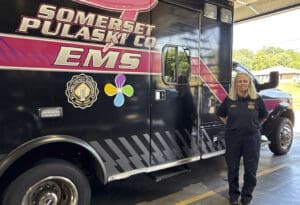30-year veteran of emergency services makes history, sets new goals for department
SOMERSET, KENTUCKY (September 30, 2025) — When she was a young girl, Tracy Sizemore’s cousin was injured in a motorcycle accident.
The two were more like siblings, being only six months apart in age. So Sizemore was paying close attention that day as her cousin received ambulatory care and was later flown to the University of Kentucky Chandler Medical Center. The way emergency services personnel cared for him — and how well he was treated — stuck with her.
It would set the trajectory for the rest of her life.
“It was something I wanted to do, I just had the passion,” Sizemore said, reflecting on that experience. “What keeps me going is that passion. I love this job. I can’t imagine doing anything else.”
Emergency services are all Sizemore has ever known. She grew up in Pulaski County, the daughter of a local law enforcement officer (her father retired at 75 from Somerset Police Department and the Pulaski County Sheriff’s Department). She often felt the heavy impact of his career, from the long hours to the missed holiday celebrations to the sacrifices he made by putting himself in harm’s way to protect his community. And she was proud of it.
In 1991, she answered her own call to serve, taking the EMT course and joining a private ambulance service in Somerset.
Thirty-four years and thousands of hours of experience later, Sizemore is back home, serving her community as chief of Somerset-Pulaski County EMS. She spent the majority of her career working for ambulance services across the region, in Pulaski, Lincoln and Laurel counties, even starting a company with a fellow paramedic to offer training for EMTs and nurses. The list of her qualifications is lengthy — her resume featuring nearly 60 different skill sets — making her stand out during the interview process.
“I knew it was going to be competitive and challenging to find the right person to succeed Chief (Steven) Eubank at EMS, who left big shoes to fill after leading this organization through trying times during a global pandemic,” Somerset Mayor Alan Keck said. “Chief Sizemore’s experience spoke for itself and spoke loudly. It was clear from the beginning that she not only had the training and leadership qualities we were looking for, but also the heart and passion for this work. I am thrilled she wanted to come back home to lead our EMS, and I am confident she will take this already outstanding organization to the next level.”
Throughout her career, Sizemore has consistently viewed Somerset-Pulaski County EMS as the gold standard for emergency services in Kentucky. When she saw the job posting for chief, although she was already in a good position as paramedic captain with Ambulance Inc. of Laurel County, she thought, “It doesn’t hurt to apply.”
“I knew I would like to come home to my home county,” she said. “I’ve never worked for any agency other than a private service. I also knew I would like to come home and finish my career closer to my family. My parents are getting older, and I just wanted to be closer. So I applied without giving it much thought.”
The rest is history, literally. Sizemore was approved by the Somerset City Council in July not only as Somerset-Pulaski EMS’s new chief, but the first-ever female chief in Pulaski County.
It’s a responsibility she takes seriously.
“It’s very exciting, but I’m also nervous because I am representing all of the females in EMS, and I hope that I do a good job and show that we can do this,” Sizemore said. “When I started in this business, there weren’t many females. It was a male-dominant job. Now there are quite a few. And I want them to know that they can move up and that they can go as far as they want to go. I hope I’m a role model for them, and that they get to see that, you know?”
A few weeks into the job, Sizemore is spending time getting to know her team and being available to them for questions or concerns. However, she’s also setting goals for the organization, identifying areas where it can improve. She wants to utilize more critical care paramedics for patient transports and participate in a cutting-edge initiative called community paramedicine. This practice uses specially trained EMS providers to deliver patient-centered, non-emergent healthcare and preventive services outside traditional hospital settings, filling gaps in care. These providers assess patients, provide follow-up care, connect them with resources, and reduce unnecessary emergency room visits and hospitalizations.
Her upbringing and experience make her keenly aware of the challenges emergency services personnel face. Mental health is at the top of that list. Sizemore is collaborating with a friend who operates Mend the Line in Danville, an organization dedicated to promoting mental health awareness among first responders, to provide her team with training and resources on dealing with trauma. Following the loss of fellow EMT Chastain McWhorter last year, Sizemore said now is an important time to introduce this resource to her team.
“Many people don’t realize what we see every day, and mentally, it does wear you down,” Sizemore said. “Some people handle it better than others, but it’s always there in your mind. So I think mental health is one of the biggest challenges to tackle.”
But because she’s spent the better part of the last three decades treating patients, Sizemore also says she’s eager to get back in an ambulance, not limiting herself to work behind a desk. It’s a good way for her to see what’s happening in the field, she said, but also keeps her close to the reason she started this career in the first place: Caring for people.
“I know I’m in the office now, but my plans are to still go on runs,” she said. “I want to be out there because I have been, up until this position. I was an officer (in Laurel County), but I still went because I like patient interaction and I like taking care of people. So that’s my goal. I’ll probably do it until the day I can’t.”


